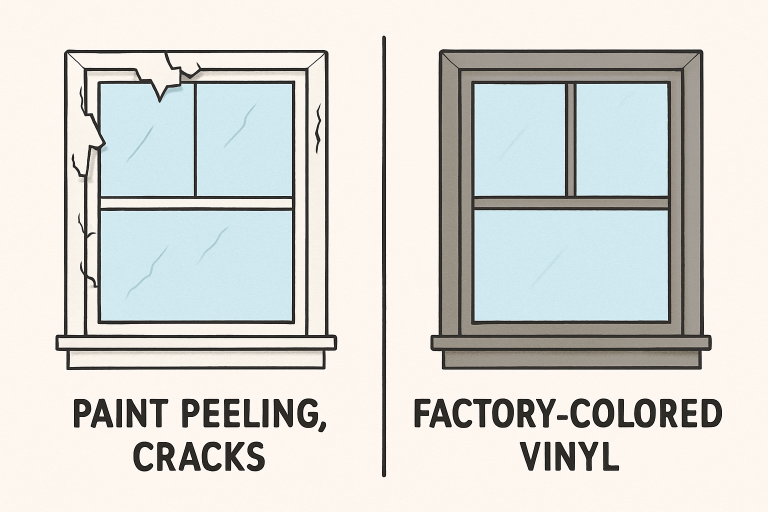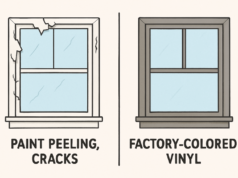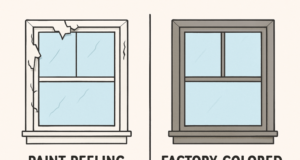Understanding Vinyl Windows
Vinyl windows have surged in popularity among homeowners for several reasons: they are durable, energy efficient, and require minimal upkeep. Made from polyvinyl chloride (PVC), vinyl windows resist rot, corrosion, and weathering, which makes them a cost-effective choice compared to traditional wood or aluminum alternatives. One of the key attractions is that, unlike wood, vinyl does not demand seasonal painting or staining to maintain its appearance.
Still, some homeowners wonder, can you paint vinyl windows? While the concept might seem like a simple solution for a fresh look, the reality is far more complicated. Many are drawn by the allure of updating their exterior color scheme, yet the specifics of vinyl as a material introduce unique challenges when paint is involved.
Most vinyl windows are crafted with color infused throughout the material during manufacturing, which means their color is designed to endure. Unlike surfaces that accept paint naturally, vinyl’s slick and non-absorbent texture makes adhesion tricky, often resulting in an uneven or unreliable finish. Home improvement experts caution that, despite the temptation, painting vinyl is best avoided unless you’re ready to deal with increased maintenance and potential complications.
The Challenges of Painting Vinyl Windows
Choosing the right exterior upgrades is an important part of protecting your home’s property value. For those who want alternatives to painting, understanding the care requirements of vinyl versus wood or aluminum is crucial. According to the U.S. Department of Energy, vinyl is among the most energy-efficient window frame materials, further contributing to its popularity with homeowners.
At first glance, painting vinyl seems straightforward, but multiple challenges quickly come into play:
- Adhesion Issues:Because vinyl is non-porous, paint doesn’t bond easily. Even specialty paints formulated for plastics often peel, chip, or flake off, resulting in a less-than-attractive appearance within months of application.
- Thermal Expansion:Vinyl windows expand and contract as outdoor temperatures fluctuate. Most paints, especially inexpensive or standard varieties, do not flex as the vinyl does, leading to cracks and a patchy finish.
- Warranty Concerns:Many window manufacturers expressly state that painting vinyl windows will void the warranty, leaving you unprotected for future repairs or defects.

Potential Damage from Painting
Beyond surface issues, painting vinyl windows can lead to more severe consequences:
- Heat Absorption:Dark paints absorb more heat, leading to significant thermal buildup. Excess heat can deform, warp, or crack the vinyl frame, undermining both aesthetics and structural stability.
- Increased Maintenance:The time and labor savings of vinyl evaporate when you add regular repainting, touch-ups, and inspections for chipping or fading. This undermines the very reason homeowners often select vinyl windows in the first place.
Manufacturer Recommendations
Most reputable window manufacturers strongly advise homeowners against painting vinyl windows. For example, Milgard Windows, a leading brand, explicitly states that painting their vinyl products constitutes an alteration and automatically voids the warranty. The same caution applies to several other major brands. Before making any changes, always review your existing window warranty documentation or contact the manufacturer for clarification. This step is vital to protect your investment and avoid unnecessary expenses down the line. According to an expert review from Consumer Reports, modifying or painting vinyl can degrade window performance, especially in terms of insulation and energy efficiency.
Alternative Solutions
If you’re dissatisfied with your current window color, there are safer and more effective ways to refresh your home’s look without risking damage or voiding warranties:
- Window Replacement:Replacing your windows with new units in your preferred color ensures a lasting, factory-finished appearance while preserving all product warranties and insulation performance.
- Exterior Trim Updates:Instead of changing the window frame color, consider updating your home’s exterior trim or siding. Painting the trim can freshen up your curb appeal without affecting the window’s structure or function.
These alternatives usually cost more upfront than a can of paint, but they offer considerable long-term advantages, such as sustained durability, consistent appearance, and peace of mind that your upgrades won’t backfire.
Conclusion
Painting vinyl windows can create more problems than it solves, including peeling, cracking, warping, and the voiding of warranties. Rather than subjecting your windows to unnecessary risk, consider professional alternatives that preserve the value, appearance, and efficiency of your investment. Homeowners will benefit more from long-lasting solutions—like window replacement or cosmetic updates to trim—than from quick fixes that are likely to disappoint in the long run.














